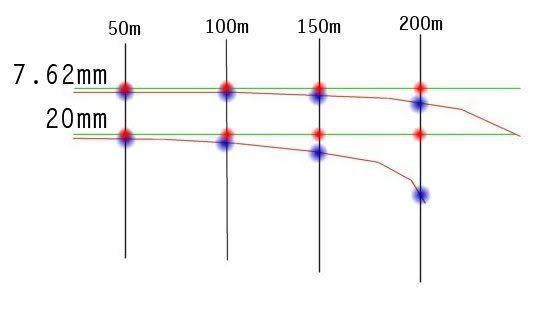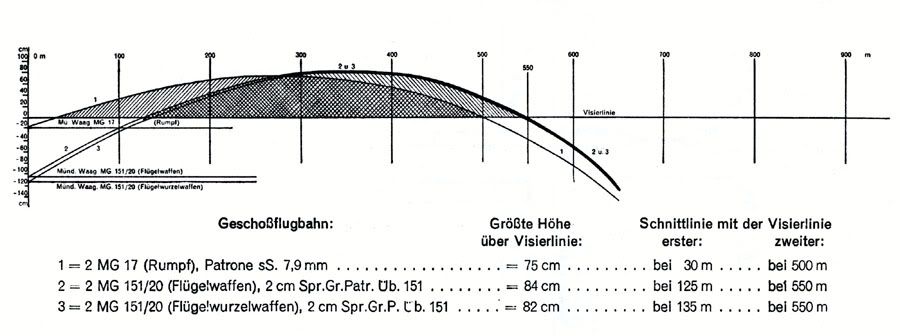
 |
|
#91
|
|||
|
|||
|
Ok, me bugging again. I can be a nuisance, I know.
But please bear in mind that i'm just concerned about the things that could be improved in a future release. So this is not plane criticism, I really appreciate the work TD has done so far and I'm confident that the game will get even better thanks to them. And of course I'm ready to aacept that I'm wrong on this one. What I see in the game is this:  What I think it should be is this:   But again, I have been wrong so many times that once again won't have much impact
__________________

Last edited by [URU]BlackFox; 02-29-2012 at 09:04 PM. |
|
#92
|
|||
|
|||
|
Yes. You can easily see this if you look at tracks of planes firing low muzzle-velocity guns from a stationary view.
For that matter, you test it yourself. Aim directly at a non-maneuvering target 600 meters out at your 12 o'clock level. Shoot a long burst. Quickly switch to exterior enemy view (Ctrl-F2). Watch the bullets pass beneath your target. Or just fly straight, slow and level over water. Shoot your guns. Watch as the bullets hit the water. |
|
#93
|
|||
|
|||
|
Well, considering the longest distance that you can set your convergence in the game is 1000 metres, the bullets won't rise all that much above the aiming line at that time.
If you want the maths, here goes: The muzzle velocity of most weapons in the game is somewhere between 500-1000 m/s: 540 m/s for MK108 720 m/s for MG151/20 850 m/s for Browning .303-cals 890 m/s for Browning .50-cals 960 m/s for MG151/15 The bullet drop distance is simple to calculate: y = ½ g t² where g = 9.80665 m/s² t = bullet travel time Notwithstanding the drag that the bullet experiences, which slows its velocity, we can still get some guidelines by assuming that the bullet travels at its muzzle velocity the entire way from the muzzle to the target. So if we look at the slowest projectile here, MK108 grenade, and assume that the average velocity is something in the order of 500 m/s, we can determine that the travel time for 1000 metres convergence is two seconds. Now we substitute this in the equation to determine how much the bullet falls during this time: y = ½ * 9.80665 m/s² * (2 s)² = ½ * 9.80665 * 4 m = 19.6 metres Now, to get how much higher the bullet must arc, you can divide this by two since the bullet first goes up, then down. So, with the MK108 cannon, firing at level attitude to 1000 metres distance at 1000 metres convergence, the projectile should have peak altitude about 10 metres higher than the aiming line. At 500 metres distance, 10 metres deviation above the aiming line is not easy to see, in fact on the computer screen it is not very many pixels; a single seat fighter aircraft's wingspan (or length) are of the same order of size, so there's your measure stick. Note that the MK108 cannon is rather slow and you probably stand no chance of either hitting anything at that distance, or to accurately see the projectile arcing higher than the aiming line because the recoil will probably throw your sight around quite a bit. With the faster projectiles, the effect is even less pronounced. The MG151/15 cannon projectile should pass the distance of 1000 metres in close to one second, and in that time, the projectile drop is only about five metres, and the peak altitude above aiming line is half that - 2.5 metres or close to that. With MG151/20 projectile, you have muzzle velocity of 720 m/s; using nice round numbers we can say the average velocity for the projectile might be something around 700 m/s. That translates to about 1.43 seconds of flight time; rounding up let's say 1.5 seconds. 1.5 seconds gives a bullet drop of about 11 metres, and thus the peak altitude would be around 5.5 metres above aiming line. Now, I don't know exactly HOW much the drag affects projectiles in distances below 1000 metres. If it's modeled physically accurately, then the heavier projectiles should technically retain their speed better while the smaller projectiles would decelerate faster due to their higher dragcoefficient/mass ratio (small stones have lower terminal velocity than big stones of same shape and density), but I don't think it will have that much of an effect on this rudimentary mathematics. The point is, since maximum convergence distance is 1000 metres, the projectiles won't arc very much above the line of sight, with exception of the slowest projectiles. The situation would be different if you could set convergence to, say, 2000 or 3000 metres, but then this would only be useful if we had an A-10 Warthog in the game with its GAU-8 cannon... |
|
#94
|
|||
|
|||
|
I see now. Thanks a lot for the explanation. I really thought the vertical correction was more significant.
__________________

|
|
#95
|
|||
|
|||
|
@Black Fox:
Thats quite funny since you posted those documents. See the 2nd one? That part with "Größte Höhe über Visierlinie" (75; 84; 82cm). This translates into "max height (of bullet's flightpath) above your line of (aiming) sight. Those MG rounds pass the LOS the 1st time at 30m and the 2nd time (when falling down) at 500m. Between 30m and 500m the max height above the LOS are those 75cm. Since this is obviously not a conv of 1000m it isn't that much and pretty much reflects what Herra Tohtori said. |
|
#96
|
|||
|
|||
|
I don´t speak German. And some characters I just couldn't type in my keyboard (which is spanish, BTW, I'm from Uruguay). So the graphical message is the one I coul get. And curves seem to be greater than RL trajectories.
Anyway, I got a free physics lesson and now I understand better how it works. So in all, it was a good deal for me
__________________

|
|
#97
|
|||
|
|||
|
I found this note in web. I hope this help other people.
I resolve my problem about landing procedure. Remember prop pitch set to auto and power at 20-30%. Altitude for landing circuit 400/500 m Warning! the stall occours at left side below 160 km/h. ---Landing--- Lower Flaps and Gear under 300 km/h (162 kt). Approach Speed is 210 km/h (113 kt). Speed at Treshold should be 190 km/h (103 kt). Flare to Threepoint attitude before touchdown. After Touchdown use Rudder to keep the Aircraft straight. Don't forget to release Tailwheel lock ( Ctrl-l) before taxiing off the Runway. |
|
#98
|
|||
|
|||
|
I've been out of practice for a bit, but the main differences in the FM I notice are
(Offline quick missions) - The Yak3 not cannot get away that easily any more in any form of combat move. the FW is not bleeding too much energy. - I can cruise in to land at around 200 (20% throttle) and the controls are still very light, and touch down (nearly 3 point - need more practice) at around 180. This seems about right as the white flap/gear markers on the speedo are at around 220 It's still not a problem to throw around the sky, at any speed. I must just repair my pedals to test the finer points of 'airmanship'
__________________

Last edited by K_Freddie; 03-14-2012 at 07:36 PM. |
|
#99
|
|||
|
|||
|
One quick note about the muzzle speeds - different types of ammo dont have same muzzle speeds. You can see this best with MG151/20 where the tracer APIT round flies a clearly more curved path and drops more per distance than the explosive shells. The weapons are apparently zeroed for the HE shells, too.
|
|
#100
|
|||
|
|||
|
Quote:
If those numbers are correct (which I have to assume at this moment) the bullet of a MG151/20 in the wingroot of a FW190A aimed at a spot 550m away starts out about 120cm below the aiming line, crossing it for the first time at 135m distance, then actually climbs up to 84cm above the aiming line (2.04m traveld upwards) where it will be at around 350m distance, before falling back to the aiming line and meeting it a second time at 550m. This numbers actually show that Herra Tohtoris simplified math isn't far off for (relative) short distances. However if the distance becomes longer the projectile becomes slower and the drag becomes less marginal. |
 |
|
|